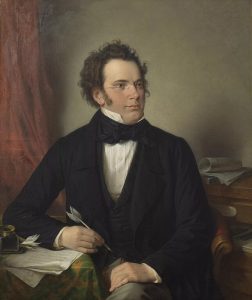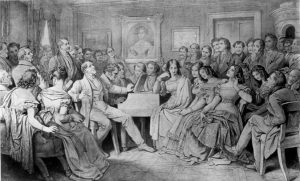3. Music of Franz Schubert (1797–1828)
Franz Schubert lived a short but prolific musical life. Like Joseph Haydn, he performed as a choirboy until his voice broke. He also received music lessons in violin, piano, organ, voice, and musical harmony, and many of his teachers remarked on the young boy’s genius. Schubert followed in his father’s footsteps for several years, teaching school through his late teens, until he shifted his attention to music composition fulltime in 1818. By that time he had already composed masterpieces for which he is still known, including the lied (German, art song), Der Erlkönig (The Erlking), which we will discuss below. Schubert spent his entire life in Vienna in the shadow of the two most famous composers of his day—Ludwig van Beethoven, whose music we have already discussed, and Gioachino Rossini, whose Italian operas were particularly popular in Vienna in the first decade.

Inspired by the music of Beethoven, Schubert wrote powerful symphonies and chamber music, which are still played today; his “Great” Symphony in C major is thought by many to be Schubert’s finest contribution to the genre. He wrote the symphony in 1825 and 1826, but it remained unpublished and perhaps unperformed until Robert Schumann discovered it in 1838. Schumann famously remarked on the “heavenly length” of this composition that can take almost an hour to perform. One reason for its length is its melodic lyricism, although the symphony also reflects the motivic developmental innovations of Beethoven.
Schubert also wrote operas and church music. His greatest legacy, however, lies in his more than 600 lieder (plural form of lied). His songs are notable for their beautiful melodies and clever use of piano accompaniment, and bring together poetry and music in an exemplary fashion. Most are short, standalone pieces of one and a half to five minutes in length, but he also wrote a couple of song cycles. These songs were published and performed in many private homes and, along with all of his compositions, provided so much entertainment in the private musical gatherings in Vienna that these events were renamed as Schubertiades (see Figure 6.11, the famous depiction of one Schubertiade by the composer’s close friend Moritz von Schwind, painted years after the fact from memory in 1868).

Many of Schubert’s songs are about romantic love, a perennial song topic. Others, such as The Erlking, put to music romantic responses to nature and to the supernatural. The Erlking is strikingly dramatic, a particular reminder that music and drama interacted in several 19th-century genres, even if their connections can be most fully developed in a lengthy composition, such as an opera.
Focus Composition: Der Erlkönig (The Erlking)
Schubert set the words of several poets of his day to his music, and The Erlking (1815) is drawn from the poetry of the most famous, Johann Wolfgang von Goethe. The Erlking tells the story of a father who is rushing on horseback with his ailing son to the doctor. Delirious from fever, the son hears the voice of the Erlking, a grim reaper sort of king of the fairies, who appears to young children when they are about to die, luring them into the world beyond. The father tries to reassure his son that his fear is imagined, but when the father and son reach the courtyard of the doctor’s house, the child is found to be dead.
As you listen to the song, follow along with its words. You may have to listen several times in order to hear the multiple connections between the music and the text. Are the ways in which you hear the music and text interacting beyond those pointed out in the listening guide?
Listening Guide
Dietrich Fischer Dieskau, baritone and Gerald Moore, piano
Composer: Franz Schubert (1797–1828)
Composition: Der Erlkönig (The Erlking)
Date: 1815
Genre: art song
Form: through-composed
Nature of Text: original text in German
| Original text | English translation |
| Wer reitet so spät dur ch Nacht und Wind? Es ist der Vater mit seinem Kind. Er hat den Knaben wohl in dem Arm, Er faßt ihn sicher, er hält ihn warm. |
Who rides there so late through the night and wind? The father it is, with his infant so dear; He holds the boy tightly clasped in his arm, He holds him safely, he keeps him warm. |
| Mein Sohn, was birgst du so bang dein Gesicht? Siehst Vater, du den Erlkönig nicht! Den Erlenkönig mit Kron’ und Schweif? Mein Sohn, es ist ein Nebelstreif. |
“My son, why do you anxiously hide your face?” “Look, father, is it not the Erlking! The Erlking with crown and with train?” “My son, it is the mist over the clouds.” |
| Du liebes Kind, komm geh’ mit mir! Gar schöne Spiele, spiel ich mit dir, Manch bunte Blumen sind an dem Strand, Meine Mutter hat manch gülden Gewand. |
“Oh, come, dear child! oh, come with me! So many games I will play there with thee; On my shoreline, lovely flowers their blossoms unfold, My mother has many a gold garment.” |
| Mein Vater, mein Vater, und hörest du nicht, Was Erlenkönig mir leise verspricht? Sei ruhig, bleibe ruhig, mein Kind, In dürren Blättern säuselt der Wind. |
“My father, my father, and do you not hear The words that the Erlking softly promises me?” “Be calm, stay calm, my child, The wind sighs through the dry leaves.” |
| Willst feiner Knabe du mit mir geh’n? Meine Töchter sollen dich warten schön, Meine Töchter führen den nächtlichen Reihn Und wiegen und tanzen und singen dich ein. |
“Will you come with me, my child? My daughters shall wait on you; My daughters dance each night, And will cradle you and dance and sing to you.” |
| Mein Vater, mein Vater, und siehst du nicht dort Erlkönigs Töchter am düsteren Ort? Mein Sohn, mein Sohn, ich seh’es genau: Es scheinen die alten Weiden so grau. |
“My father, my father, and do you not see, The Erl-King’s daughters in this dreary place?” “My son, my son, I see it aright, The old fields appear so gray.” |
| Ich lieb dich, mich reizt deine schöne Gestalt, Und bist du nicht willig, so brauch ich Gewalt! Mein Vater, mein Vater, jetzt faßt er mich an, Erlkönig hat mir ein Leids getan. |
“I love you, I’m charmed by your lovely form! And if you’re unwilling, then force I’ll employ.” “My father, my father, he seizes me fast, Full sorely the Erl-King has hurt me at last.” |
| Dem Vater grauset’s, er reitet geschwind, Er hält in den Armen das ächzende Kind, Erreicht den Hof mit Mühe und Not, In seinen Armen das Kind war tot. |
The father, horrified, rides quickly, He holds in his arms the groaning child: He reaches his courtyard with toil and trouble,— In his arms, the child was dead. |
Performing Forces: solo voice and piano
What we want you to remember about this composition:
- It is an art song that sets a poem for solo voice and piano.
- The poem tells the story of three characters, who are depicted in the music through changes in melody, harmony, and vocal range.
- The piano sets general mood and supports the singer by depicting images from the text.
Other things to listen for:
- Piano introduction that outlines a minor scale (perhaps the wind)
- Repeated fast triplet pattern in the piano, suggesting urgency and the running horse
- Shifts of the melody line from high to low range, depending on which character is “speaking”
- Change of key from minor to major when the Erlking sings
- The slowing note values at the end of the song and the very dissonant chords
| Timing | Performing Forces, Melody, and Texture | Text and Form |
| 0:00 | Piano introduction opens with a fast-tempo melody that begins low in the register played by the left hand, ascending through the minor scale and then descending, accompanied by repeated triplet octaves. The ascending/ descending melody may represent the wind. The minor key suggests a serious tone. The right-hand repeated octaves using fast triplets may suggest the running horse and the urgency of the situation. | |
| 0:24 | Solo voice starts, accompanied by piano in homophonic texture. Melody falls in the middle of the singer’s range. | Narrator: Who rides so late through night and wind? |
| 0:56 | Melody drops lower in the singer’s range. | Father: My son, why are you frightened? |
| 1:04 | Melody shifts higher in range. | Son: Do you see the Erlking, father? |
| 1:19 | Melody drops lower in range. | Father: It is the fog. |
| 1:29 | The key switches from minor to major, perhaps to suggest the friendly guise assumed by the Erlking. Softer dynamics and lighter piano articulation | The Erlking: Lovely child, come with me… |
| 1:52 | Back in minor and the melody hovers around one note high in the singer’s range; the minor mode reflects the son’s fear, as does the melody, which repeats the same note, almost as if the son is unable to sing another. | Son: My father, father, do you not hear it… |
| 2:04 | Melody drops lower in range. | Father: Be calm, my child, the wind blows the dry leaves… |
| 2:13 | Back to a major key and piano dynamic for more from the Erlking | The Erlking: My darling boy, won’t you come with me… |
| 2:30 | Back to minor and the higher-ranged melody that hovers around one pitch for the son’s retort | Son: My father, can you not see him there? |
| 2:42 | Melody drops lower in range and the louder repeated triplets return. | Father: My son, I see well the moonlight on the grey meadows…. |
| 2:58 | Momentarily in major and then back to minor as the Erlking threatens the boy | The Erlking: I love you…if you do not freely come, I will use force… |
| 3:09 | Back to minor and the melody higher in range | Son: My father, he has seized me… |
| 3:22 | Back to the melody in the middle range like the beginning; the tempo picks up. | Narrator: The father, filled with horror, rides fast |
| 3:37 | Tempo slowed down, which may echo the slowing down of the horse; a total silence followed by the voice singing alone; quiet piano chords and then a strong piano cadence to conclude The truncated chords and strong final minor chords buttress the announcement that the child is dead. |
Narrator: They arrive at the courtyard. In his father’s arms, the child was dead. |
The next generation of 19th-century composers—born in the first two decades of the century—included a number of talented pianists: Felix and Fanny Mendelssohn, Robert and Clara Schumann, Fryderyk Chopin, and Franz Liszt. They were joined by orchestra composer Hector Berlioz and a slightly younger composer who might be considered Berlioz’s alter ego, Johannes Brahms.
A composition setting a poem to music, generally for one solo voice and piano accompaniment; in German, a Lied.
A collection of art songs, unified by poet, narrative, musical style, or composer.
Songs or musical compositions in which new music is composed for each stanza or section with no repetition.
